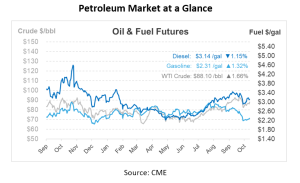
What Is It – Department of Energy (DOE)
The Department of Energy (DOE) is a significant entity within the U.S. government, overseeing a vast array of responsibilities ranging from nuclear safety to energy conservation. Among its many duties, the DOE plays a central role in shaping the nation’s policies and regulations concerning the oil and gas industry. Today’s What Is It Wednesday will provide an overview of the Department of Energy and how it comes into play with the petroleum industry.
What is the Department of Energy (DOE)?
Established in 1977 by President Jimmy Carter, the Department of Energy was created in response to the energy crises of the 1970s. Its primary goal was to consolidate various federal agencies responsible for energy-related tasks into a single department. This would streamline policymaking and ensure a cohesive energy strategy for the nation.
Today, the DOE’s mission extends far beyond the scope of just energy. The agency is responsible for advancing the national, economic, and energy security of the US while promoting scientific and technological innovation. Overseeing the country’s nuclear weapons program for the Navy, the DOE also ensures environmental cleanup from the nation’s nuclear weapons research and production activities.
The DOE and the Petroleum Industry
The oil and gas sector is crucial to the U.S. economy, not only for the jobs it creates and the energy it produces but also for the revenues it generates for federal, state, and local governments. The DOE, through its Office of Fossil Energy and Carbon Management, oversees the country’s fossil energy resources. Its responsibilities related to the petroleum industry include:
Research and Development: The DOE funds and coordinates research aiming to improve the efficiency and environmental compatibility of fossil fuel technologies.
Strategic Petroleum Reserve: Established post the 1973-74 oil embargo, this reserve holds emergency crude oil stocks to counter any significant supply disruptions.
Regulation and Oversight: The DOE monitors the petroleum industry’s practices, ensuring they are in line with national policies, particularly those concerning environmental protection and energy conservation.
Data Collection and Analysis: The U.S. Energy Information Administration (EIA), a part of the DOE, provides impartial data, forecasts, and analyses on energy production, stocks, demand, imports, exports, and prices. This data is invaluable to petroleum industry players and policymakers.
Petroleum Product Influences of the DOE
One significant domain influenced by the DOE is pricing. While it’s clear that oil and gas markets are swayed by global events and dynamics, domestic factors can also play a pivotal role. For instance, policies implemented by the DOE, such as the emergency drawdowns from the Strategic Petroleum Reserve or regulatory changes, can cause fluctuations in prices, especially in the short term.
Beyond just pricing, the DOE also plays a role in setting environmental standards. Their research and established guidelines often result in more stringent environmental regulations. This not only sets the bar for operational procedures in the petroleum industry but can also influence the kind of products that make their way to the market. Occasionally, these standards can also affect product prices.
The future of energy is closely intertwined with innovation. The DOE’s investment in research often paves the way for technological advancements. These breakthroughs have the potential to introduce cleaner or more efficient alternatives within the petroleum-based product spectrum.
Popular DOE Publications
The DOE, through its Energy Information Administration (EIA), releases a number of publications and reports that are helpful for our industry in keeping up with the production and consumption of crude oil, import and export data, emissions regulations and projections, and so much more. One popular publication is the Short-Term Energy Outlook (STEO), a monthly publication that provides projections and analyses of energy markets in the U.S. and globally. The STEO is a comprehensive source of projections for the next 13-24 months. It helps policymakers, businesses, and the general public understand current energy trends and what might be expected in the near future.
Another popular publication is the Weekly Petroleum Status Report. This weekly report provides a snapshot of the U.S. petroleum balance, covering data on crude oil and petroleum product inventories, imports, and production. Today in Energy is a daily publication that includes a brief analytical with topical articles on current energy issues and trends.

This article is part of Daily Market News & Insights
Tagged:
MARKET CONDITION REPORT - DISCLAIMER
The information contained herein is derived from sources believed to be reliable; however, this information is not guaranteed as to its accuracy or completeness. Furthermore, no responsibility is assumed for use of this material and no express or implied warranties or guarantees are made. This material and any view or comment expressed herein are provided for informational purposes only and should not be construed in any way as an inducement or recommendation to buy or sell products, commodity futures or options contracts.





